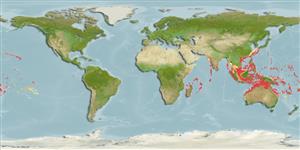Common names from other countries
Environment: milieu / climate zone / depth range / distribution range
экология
морской ассоциированный с рифами; немигрирующий; пределы глубины 0 - 110 m (Ref. 128797), usually 30 - 108 m (Ref. 9710). Tropical; 32°N - 30°S, 40°E - 131°W (Ref. 5222)
Indo-Pacific: Pinda, Mozambique (15°S) to French Polynesia and the Pitcairn Group, north to the Ryukyu Islands, south to Heron Island at the southern end of the Great Barrier Reef. Often misidentified as Cephalopholis aurantia (or as Cephalopholis analis, a junior synonym of Cephalopholis aurantia).
Size / Вес / Возраст
Maturity: Lm ? range ? - ? cm
Max length : 30.0 cm TL самец/пол неопределен; (Ref. 48636)
колючие лучи спинного плавника (общее число) : 9; членистые (мягкие) лучи спинного плавника (общее число) : 14 - 16; колючие лучи анального плавника: 3; членистые (мягкие) лучи анального плавника: 9 - 10. Characterized by pinkish red to pale reddish orange color; mottling of darker red to brownish red; median fins with narrow blue marginal stripe; body scales ctenoid, cycloid scales ventroanteriorly on abdomen; greatest depth of body 2.7-3.2 in SL; rounded caudal fin; pelvic fins 1.9-2.2 in head length (Ref. 90102); eyes large, diameter about twice the depth of the preorbital; interorbital area flat; rounded preopercle, very finely serrate, shallow notch, fleshy lower edge; smooth or with serrae subopercle and interopercle; scaly maxilla, reaching to or well beyond vertical at rear edge of eye (Ref. 089707).
Perhaps the most common grouper on Indo-Pacific coral reefs found below 40 m. The species is only known from insular localities except those collected from Pinda, Mozambique. Feeds on crabs and other crustaceans (Ref. 89972). The small size (<22 cm TL) and deep-water habitat of this species makes it less vulnerable to fishing (Ref. 58472). Solitary (Ref 90102).
Life cycle and mating behavior
Maturities | размножение | Spawnings | Egg(s) | Fecundities | личинки
Heemstra, P.C. and J.E. Randall, 1993. FAO Species Catalogue. Vol. 16. Groupers of the world (family Serranidae, subfamily Epinephelinae). An annotated and illustrated catalogue of the grouper, rockcod, hind, coral grouper and lyretail species known to date. Rome: FAO. FAO Fish. Synop. 125(16):382 p. (Ref. 5222)
Статус Красного Списка МСОП (Ref. 130435)
CITES (Ref. 128078)
Not Evaluated
Угроза для людей
Harmless
Использование человеком
рыболовство: не имеет хозяйственного значения; объект спортивного рыболовства: да
дополнительная информация
инструменты
Специальные отчеты
Скачать в формате XML
ресурсы в Интернет
Estimates based on models
Preferred temperature (Ref.
115969): 21.2 - 28.1, mean 26 (based on 411 cells).
Phylogenetic diversity index (Ref.
82804): PD
50 = 0.5000 [Uniqueness, from 0.5 = low to 2.0 = high].
Bayesian length-weight: a=0.01585 (0.00943 - 0.02663), b=3.08 (2.94 - 3.22), in cm Total Length, based on LWR estimates for this species & Genus-body shape (Ref.
93245).
Trophic level (Ref.
69278): 4.0 ±0.7 se; based on size and trophs of closest relatives
устойчивость к внешним воздействиям (Ref.
120179): средний (среднего размера), минимальное время удвоения популяции 1.4-4.4 года (Preliminary K or Fecundity.).
Fishing Vulnerability (Ref.
59153): Low vulnerability (20 of 100).
